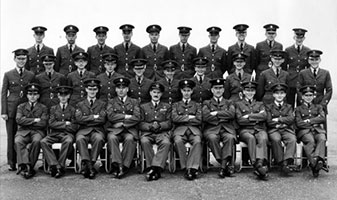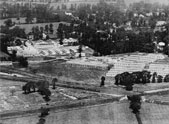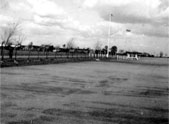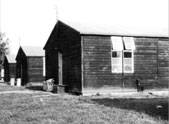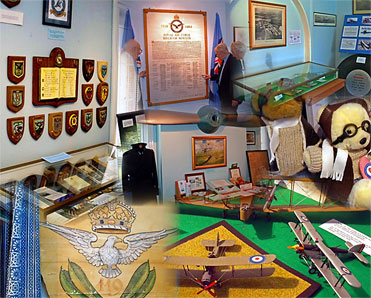We all love a bit of nostalgia don’t we? Ask yourself how many times you have been somewhere and have deviated from your itinerary to have a look at that familiar old and probably now derelict RAF station where you once served all those years ago, or perhaps gone back to look round that town where you once served, lived or owned your first house.
Most ex-servicemen from all three services particularly those who served during or in the immediate post war era seem to be able to retain that unusually strong bond between them that seems never to fade. Ex-Admin Apprentices are no exception! Shared hardships and experiences are powerful bonding agents I think you will agree. Most of us for example still cannot help but tap our feet to the sound of a military band recalling memories of bull, parade grounds and drill instructors bawling in our ears. The sights and sounds of the a big military parade, the Royal Tournament or the Remembrance parade at the Cenotaph can bring tears to our eyes. ‘Those were the days’ I hear you cry, as the veterans march proudly by heads held high displaying chests full of medals.
Well here is an opportunity Immerse yourself in the stuff. Take time to browse our comprehensive collection of photos and documents depicting life�as an Administrative Apprentice. In addition you can read the articles submitted by our members and selected extracts from the Association Newsletter. If you would like to find an old friend from your Apprentice days then click Find a Friend, leave his details and hold your breath!
If you can add anything new to our site then please do not hesitate to contact us. We are always on the look out for new photos or information about the Administrative Apprentice Scheme and ex-Apprentices who we may not know about., Your experiences either as an apprentice or as a member of the training staff could prove invaluable to us. If you are an ex-Admin apprentice and are not yet a member of our Association why not join? For a modest annual fee of £10.00 you can take part in various organised events and also have the opportunity to meet old friends at our Annual Reunion held each June.
A History Of The Administrative Apprentice Schemes
When Lord Trenchard, the first Chief of the Air Staff, envisaged an apprenticeship scheme for the Royal Air Force, the main focus was to be on providing skilled engineers. However, Squadron Leader J W Cordingly, Commanding Officer of the Royal Air Force Record Office at Flowerdown prior to its re-location to RAF Ruislip, suggested that skilled administration too would be required and that there should also be apprentice training for clerks in the Royal Air Force. Training began at RAF Ruislip but later training was undertaken at three other RAF units, St Athan, Hereford and Bircham Newton. With the commencement of World War II, many apprentices applied and were accepted for – aircrew duties – although one famous Commander-in-Chief was against this source of recruitment stating “We can get as many aircrew as we like, and train them quicker than we can get good, trained clerks’! Indeed, as proof of the C-in-C’s perception, many ex-apprentices were ‘poached’ by Diplomatic, Consular and other Government Departments, and one ex-apprentice retired as a Superintendent in the Metropolitan Police. With the outbreak of war, the demand for experienced clerks increased, and promotion could be quite rapid, indeed one Warrant Officer known to the writer, proudly boasted that he had never done duty as Orderly Sergeant!

During their service over the years, many ex-apprentice clerks received state and bravery awards, with Flight Lieutenant Norman Baugh, MC, a pilot and a former member of the 21st Entry, being especially worthy of mention. Taken prisoner by the Japanese in Hong Kong in December, 1941, he escaped on a makeshift raft into the Bay, and then overland, and, despite many encounters with dissidents and illness, he eventually reached Bombay and was flown back to the UK. On recovering from his privations, Flight Lieutenant Baugh returned to flying duties in Burma where, sadly, he was killed in action in January 1943. To appreciate fully what was involved in this escape, check your Atlas and note the ~ distance from Hong Kong to Bombay.
It would be inappropriate not to mention Air Vice-Marshal W Carter of the l7th Entry, the only ex-Apprentice Clerk to reach this rank. On pass-out, the Warrant Officer Discip told him ‘Boy, you have given me more trouble than most. You’ll end up smashed into a hillside, or with an Air Marshal’s baton,’ what prescience! ‘Nick’ Carter qualified as a pilot and was awarded the DFC. Later for his work in CENTO, he was made a Companion of the Bath. On retirement from the RAF he moved to Australia, selling property in Western Australia, but was quickly selected to be Commandant of the Civil Defence School in South Australia. He next became the first Director of the Australian Counter- Disaster College. On retirement at age 65, he set up his own consultancy, advising South Asian and Pacific countries, as well as the UN, and produced A Disaster Manager ‘s Handbook, still the basic guide. He remained active throughout his life, and died in – Australia aged 87.Coincidentally, or is it, of the 11 Commanding Officers of the later Administrative Apprentice Training Schools, no fewer than 4 of them were ex-Ruislipians, however, it must be noted that the very first Commanding Officer, Wing Commander D A Reddick, OBE, DFC, was an ex-Halton Aircraft Apprentice. This ‘quality checking process’ continued when two ex-Ruislip Apprentice Clerks, Air Commodore A P Vicary (then AOC RAF Record Office), and Air Commodore M C M V au, were Reviewing Officers at the Administrative Apprentice Pass-Out Parades of the 318th and 322th Entries respectively. To summarise the efficacy of apprentice training, the following statistics are offered: 3% of apprentice clerks were commissioned, four reaching air rank; 16 reaching Group Captain; 51% reached WO/SNCO rank; 21% were selected for aircrew duties; and 15% received honours and awards.
Following the success of the RAF Ruislip Apprentice Clerk Scheme that operated between 1925 and 1942, it was deemed logical to commence a similar scheme post- war. Accordingly the training of the newly-titled RAF Administrative Apprentices began in 1947 at Royal Air Force St Athan. With the increase in the school leaving-age, and following a review of the training that future apprentices would require, the syllabi were considerably revised and the Course length reduced to 12 months. Another change was in the numbering of Entries which had previously had run from Nos. 1 – 46. Now the revised Entry numbers started at No. 301 and continued consecutively up to No. 320. Then followed Entries numbered 322, 324, 326, with the final Entry being No. 330. Individual Entries in the ‘300’ block had more apprentices than in any of the previous 46 Entries, with the 330th, the final Entry, peaking at 165 apprentices. However, the most significant change at this time was for some administrative apprentices in Entries Nos. 301 – 309 to be trained as Nursing Attendants. A total of 190 were trained between September, 1964 and April, 1968, when Nursing Attendant Training ceased. Entries 301-309 were trained at MTE (Medical Training Establishment) RAF Halton, with the nursing element undertaken at PMRAF Hospital Halton. Then with Entry Nos. 310 – 314, from September, 1967 to December1969, 100 administrative apprentices were trained for Medical Secretarial duties and were trained as Med Secs. They too were medically trained at MTE but for other elements of their training they were part of No 1 School of Technical Training RAF Halton.
Craft Apprentices of the Catering Trade trained alongside Administrative Apprentices at Hereford from 1968 until the end of the Apprentice Scheme in 1973. The Service numbers allocated to the Administrative Apprentices were in a block purely relating to the Secretarial and Supply trades whereas the Service numbers allocated to Craft Apprentices (8007134 to 8015679) related to all trades and all the training schools. When I carried out my research with the Personnel Management Centre and the Disclosures Cell to put names to numbers, it proved impossible to identify individual trades in that 8,546 block. Craft Apprentices who trained as cooks are eligible to join the Association.
Webmaster Note November 2009:
Following information received from a member of the 330th entry, we are pleased to show below, accurate information relating to service numbers issued to Apprentice Clerks and Admin Apprentices:
The block of numbers allocated for Apprentice Clerks in 1925 was 590001 to 594261, which seemingly provided for the Ruislip apprentices (up to 592080) and for the entries from 1947 until the allocation was exhausted. The next batch of Administrative Apprentice numbers allocated (in Oct 64) was from 594301 to 599999; the last number actually issued was 596003. With the next batch of numbers starting at 600000 it would appear that the only individuals with 596XXX numbers were admin apprentices and there were only ever 4 of them. The list confirms that numbers 594262 to 594300 were never allocated to any elements of the RAF. Turning to the 311 to 330 entry era the list shows that a block from 8000005 to 8002157 was used rather than being allocated from the male recruit block as the web-site suggests. As a result it should be relatively easy to identify anyone from this era, with the exception of those who came to us via Halton, Cosford or Locking.
With the passing-out in August. 1973 of the 330th Entry, administrative apprentice training in the RAF ceased. Over the period May, 1947 – August. 1973, it had trained some 4,500 apprentices, and the last to leave the service was Russell (Russ) Bond (8002091) 330th entry, who left in 2012 to become a beefeater at the Tower of London. A snapshot of ex- administrative apprentice achievements (too many to mention them all), shows that others worthy of note are John Williamson of the 9th Entry who was awarded the RVM for his service on the Queen’s Flight. Bob Danes of the 33rd Entry was awarded two AFC’s for his bravery in two air/sea rescues. Bill Beedie of the 30 I st Entry was adjudged as being the most outstanding RAF apprentice of the year from the various training schools, and was awarded a Gold Medal bearing the insignia of the Argentine Air Force, and presented by the Argentine Ambassador; at this presentation incidentally, and representing the AOC-in-C, Bomber Command, was Air Vice Marshal VM Carter the ex-Ruislip Apprentice Clerk mentioned earlier. Although information is sketchy, there were doubtless a number of other ex-admin apprentices who achieved high rank, including Air Cdre John Pack of the 5th Entry. A list of those who reached Group Captain Rank including their entry numbers is shown in our General Archive Pages . In a general resume of the performance of ex-administrative apprentices, many of whom have been awarded honours, and with their varied achievements whilst serving and subsequent to their leaving the RAF, it is without doubt that their contribution to the Royal Air Force, and indeed the nation as a whole, has been as significant as that made in the past by their forebears, the RAF Ruislip Apprentice Clerks. At a reunion dinner of the 29th Entry in 1986, Reg Drinkwater an ex-drill instructor who served training Administrative Apprentices at RAF Hereford in the mid 50’s, spoke eloquently when he said ‘ My job was to turn boys into men. Looking at you now and at your outstanding achievements both in and out of the Service, I rest my case’.
A History Of Administrative Apprentice and Apprentice Clerk Hatbands – Website Manager Alan Bell
21st January 2021
I was contacted recently by John Smith (ex-74th Entry Halton) who was seeking information regarding a project he was involved with concerning apprentice hatband colours. My thanks to John for involving the Association in his research. Following our discussions and with the cooperation of our Chairman Bryan Schofield, we have agreed that the following information is as accurate a picture as can be ascertained of the various hatband colours worn by Administrative Apprentices and Apprentice Clerks throughout the duration of both schemes:
28 October 1925 Apprentice Clerks commenced training at Ruislip (Record Office)
1925 Dark blue hatbands were introduced for Apprentice Clerks (it is an assumption: about this time coloured hatbands were introduced at other apprentice training establishments).
1937 Light blue hatbands replaced dark blue for Apprentice Clerks at Ruislip (dark blue transferred to D Sqn, Cranwell).
October 1942 Apprentice Clerk training ceased at Ruislip with passing out of 61st Entry.
31 May 1947 Administrative Apprentice Wing formed in No 4 School of Technical Training at St Athan.
15 September 1948 Administrative Apprentice Training School formed at St Athan from Administrative Apprentice Wing of No 4 School of Technical Training.
Entries 1 and 2 originally wore pale blue hatbands that had been in use at Ruislip. However, earlier in 1948 the hatbands were changed to black/white diced hatbands. Entries 1-20 all wore these. Subsequently, at some point (date not known for sure this point) green hatbands were introduced.
1st Entry to 20th Entries commenced training at St Athan, although 17th Entry to 20th Entry completed their training at Hereford.
6 January 1954 Administrative Apprentice Training School transferred to Hereford, where 20th to 35th Entries trained, wearing green hatbands.
25 January 1959 Administrative Apprentice Training School transferred from Hereford to Bircham Newton (still with green hatbands). 32nd Entry was first to pass out, in March 1959. 36th to 46th Entries commenced their training at Bircham Newton; 43rd Entry was last to complete training there.
January 1963 Administrative Apprentice Training School returned to Hereford. 44th, 45th and 46th Entries passed out (wearing green hatbands) there in mixed flights of Apprentices and Boy Entrants.
13 December 63 Administrative Apprentice Training School ceased at Hereford.
September 1964 Administrative Apprentice Training School reformed, under revised Trade structure and a shorter training course, at Hereford (now with red/white diced hatbands) for 300-series entries from 301st Entry.
3rd March 2022
Website Manager Comment:
On the subject of hatband colours, it will of interest that Halton Apprentices from their 301st Entry onwards wore yellow hat bands. My thanks to Denis Carver (ex 302nd Entry Halton) for providing this information.
August 1973 Administrative Apprentice Training School disbanded at Hereford with graduation of 330th Entry.
9th April 2021
Website Manager Comment:
My apolgies to Anthony Johnstone for now picking up his comment in early February on the subject of hatbands. To clarify this, I have posted Anthony’s comments below:
2nd February 2021
From a 3rd Entry point of view I vaguely remember we were first issued with a single colour hat band, light or dark blue, and at some later stage supplied with the black and white bands. If you look at some of the old images on the website the 1st, 2nd and 3rd entries all started off with a single colour band but passed-out with a black and white band. I do not know where John Smith got the idea of green bands in September 1948, see passing out colour in September 1949. Back to the ‘drawing board’ John!
Anthony Johnstone
Looking Back – The Future For RAF Apprentices In 1938 (by Trevor Moore 14th Entry)
I recently acquired, via ebay, a copy of AM Pamphlet 36 (1938 edition). The content makes interesting reading, and I publish extracts:
“The Royal Air Force (RAF) exists primarily for the defence of the homeland, of the Empire and of the outposts of the Empire against attack in time of war, and is the guardian of peace in parts of the Empire which otherwise would be liable to tribal disturbances. It enables Great Britain to fulfill her obligations under the mandates given by the League of Nations, and it helps to police the Sudan, the North West Frontier of India and other parts of the world”
“Boys under training in the RAF are known as aircraft apprentices, boy entrants, and apprentice clerks.”
The part devoted to Apprentice Clerks states “The training establishment for apprentice clerks is part of the Record Office at Ruislip, Middlesex. Here apprentices are given approximately 18 months’ training as general or as accountant clerks. They learn the essentials of office routine and gain practical experience in the large Record Office by employment in the various sections. A progressive and carefully-graded scheme of instruction is followed, and ample supervision by experienced clerks is provided. In the school, which forms part of the establishment, the apprentice clerks are given instruction in English, shorthand and book- keeping, history, geography and economics. The prospects of a progressive career are similar to those open to an aircraft apprentice, save in the matter of cadetships at the RAF College. A strictly limited number of permanent commissions in the Equipment Branch may, for the present, be granted to ex- apprentice clerks who have attained at least the rank of corporal and are under 26 years of age. This avenue to commissioned rank is, however, subject to review from time to time. Apprentice clerks, like aircraft apprentices, if not selected for re-engagement, are given the option, on the satisfactory completion of their engagement at the age of 30, of entering the RAF Reserve for a period of four years, and receive a gratuity of £100 in lieu of the normal gratuity. Apprentice clerks are attested for a period of 12 years regular RAF service from the age of 18 years.”
Conditions of Entry. For Apprentice Clerks there were quarterly entries each year. Age limits 15½ and under 17¼ on entry by selection from among candidates who were in possession of an approved first school certificate or who had attained an equivalent educational standard at a secondary or technical school. Rates of Apprentice pay (then current) were 1s a day – 7s a week – for the first year, and then 10s 6d a week afterwards until classified as an aircraftman (on graduation). Group IV trade (clerks) initial rates were AC2 – 3s 3d a day rising to 11s 6d a day for a Warrant Officer. Accommodation, food, clothing and medical facilities were free. A family allowance, with additions for each child under 14 years of age, was normally issuable in respect of married airmen who had attained the age of 26.
(I note that typing/keyboard skills were not mentioned in the trade tuition?)
Website Manager Note:
I recommend you visit this page for further information regarding the Administrative Apprentice Scheme


 administrator@rafadappassn.org
administrator@rafadappassn.org